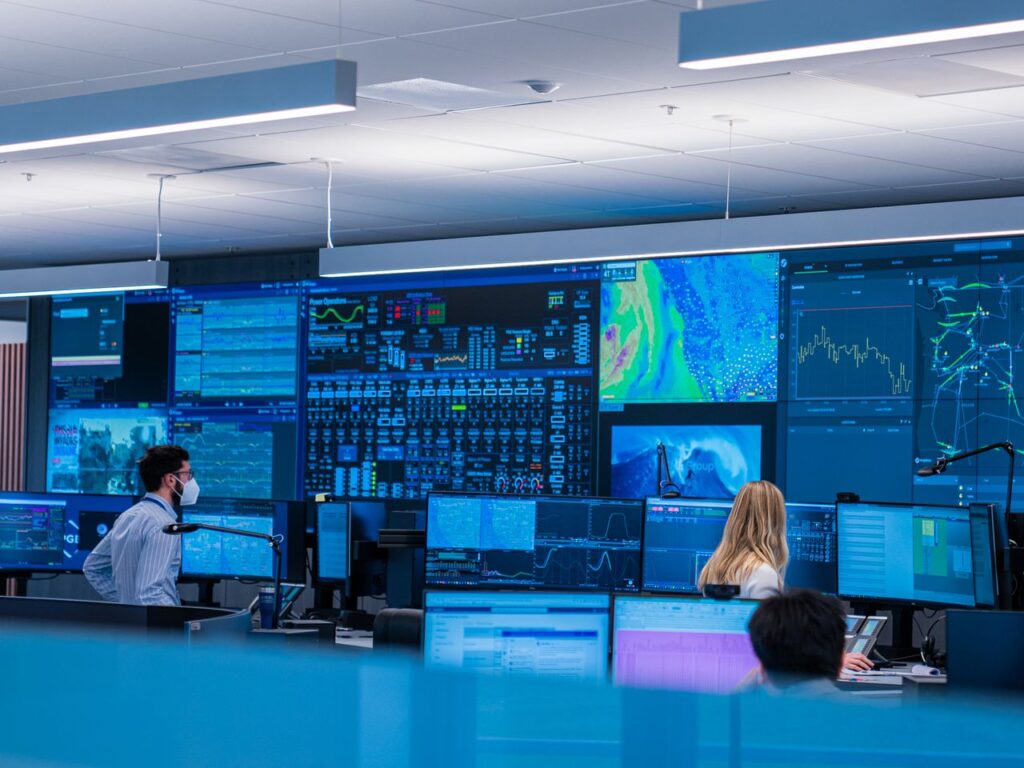Activu customer, PGE, discusses its mission-critical operations center for increased resilience and security, using the latest industry-leading technology from Activu.

When you flip the light switch or turn up your thermostat, you expect the juice to start flowing. It’s as simple as that.
But in an age of distributed power generation and storage, intermittent renewables, electric cars, smart grid technology, fast-changing wholesale electricity markets, climate change and ever-present cyber threats, the old model of providing reliable and affordable power is being turned on its head.
PGE’s new Integrated Operations Center in Tualatin centralizes its mission-critical operations for increased resilience and security.
When you flip the light switch or turn up your thermostat, you expect the juice to start flowing. It’s as simple as that.
But in an age of distributed power generation and storage, intermittent renewables, electric cars, smart grid technology, fast-changing wholesale electricity markets, climate change and ever-present cyber threats, the old model of providing reliable and affordable power is being turned on its head.
For Portland General Electric and its 900,000 customers in Oregon, nowhere is that more apparent than at its integrated operations center in Tualatin. The futuristic, $207 million building is the utility’s new nerve center, tying together management of its far-flung fleet of power plants, energy storage facilities, transmission and local distribution lines, energy trading, emergency operations, meteorologists and other mission-critical functions under one, very secure roof.
The low-slung brown building doesn’t look remarkable from outside, apart from a few unusual features like a helipad and a large array of backup generators. But step inside and the atmosphere is out of mission control at NASA. Vast wall-size displays allow employees to monitor and control PGE’s entire system – and the factors affecting it – in real time. The power output at the Grand Coulee Dam. Wholesale energy prices throughout the West. Outages in its local distribution system. The status of an auxiliary pump at a distant gas-fired power plant. Whether the sun is going to shine or the wind blow. The world news.
When PGE needs to draw on its battery array in Salem, tap a diesel generator at a hospital, turn up the thermostats in customers’ homes by a few degrees to lighten its air conditioning load during a heat wave, or respond to an unplanned outage, the orders now go out from Tualatin.
The building was conceived in 2015 amid growing awareness of the probability of a catastrophic Cascadia Subduction Zone earthquake. It took two years to build, opened in October, and is hardened to withstand and help the utility recover from virtually any natural or man-made disaster.

Those threats, and their impact on the grid, are evident to anyone who has lived through the Pacific Northwest’s recent heat dome, wildfires, ice storm or even this week’s surprise snowstorm – and the resulting power outages. But the ability to monitor its equipment and conditions through sensors, cameras and an increasing array of remote weather stations, for example, should decrease the risk of utility-caused fires and improve its response time to any weather-related event or outage.
“When someone tells me it’s a one-in-40-year event, I’m starting to lose faith that they’re one in 40,” said Larry Bekkedahl, PGE’s senior vice president of advanced energy delivery, who hosted a media tour of the building Thursday.
Increasingly, those risks are man-made, from nation-states, cyber criminals or hacktivists looking to crack into utility networks through an ever-multiplying set of online doorways.
“Every day, someone jiggles the doorknob,” said Chris Nolke, the utility’s director of cyber security and IT governance. “We see all sorts of different probing and attempts. Their hope is that we will make an operational mistake.”
To prevent that from happening, Nolke said PGE works with other utilities in the region to understand the evolving nature of those threats, running models and simulating various events to identify and isolate vulnerabilities – essentially rehearsing bad things.
“It’s a perpetual running race,” he said.
The Tualatin facility houses a number of different functions that used to be spread between PGE’s headquarters at Portland’s World Trade Center and other facilities. The aim is more integration, better visibility into operations and easier collaboration between teams. That coordination, utility officials say, will be key to delivering the flexible, reliable and clean energy system that lawmakers, regulators and customers are demanding.

Home to 220 employee and capable of surging to 350, the facility can operate independently – water, sewage, backup power, food – for two weeks, and sits on isolators that would allow it to move 18 inches in any direction during an earthquake.
Even the pandemic has had a big impact on electricity demand, or in industry parlance, the shape of the load throughout the day, said Dee Outama, senior director of energy supply. The ramp in demand is steeper in the morning as stay-at-home workers get up, shower, turn on their coffee machines and computers, he says, pointing to a display monitoring the roller coaster of customer demand over a week’s period.
PGE needs to balance that demand exactly with its own generation or market purchases, and energy traders now sit alongside its power operations group at the building to optimize efficiency.
That balancing act is becoming far more technically complicated as the region’s utilities move incrementally toward a unified west-wide energy market. That promises much more efficient use of the grid and access to the cheapest sources of electricity throughout the day – something PGE will be monitoring from Tualatin. But it’s technically daunting and politically fraught, as utilities are loathe to give up control of their transmission assets to a more centralized balancing authority, particularly if that authority is in California.
“It’s the unicorn we’ve been chasing since the nineties,” Outama said. “We’re moving toward it in bite- size chunks.”
– Ted Sickinger; tsickinger@oregonian.com; 503-221-8505; @tedsickinger

